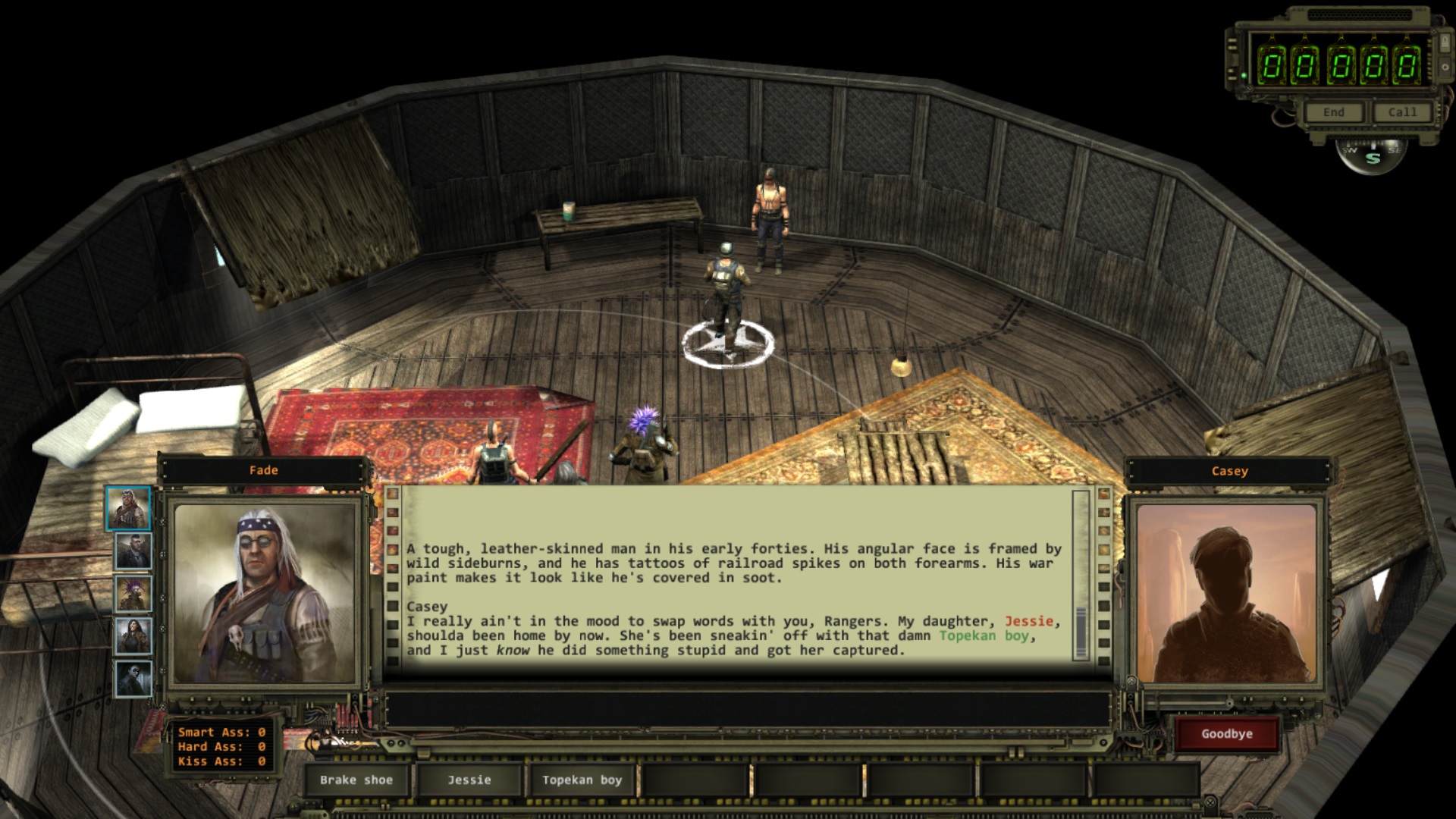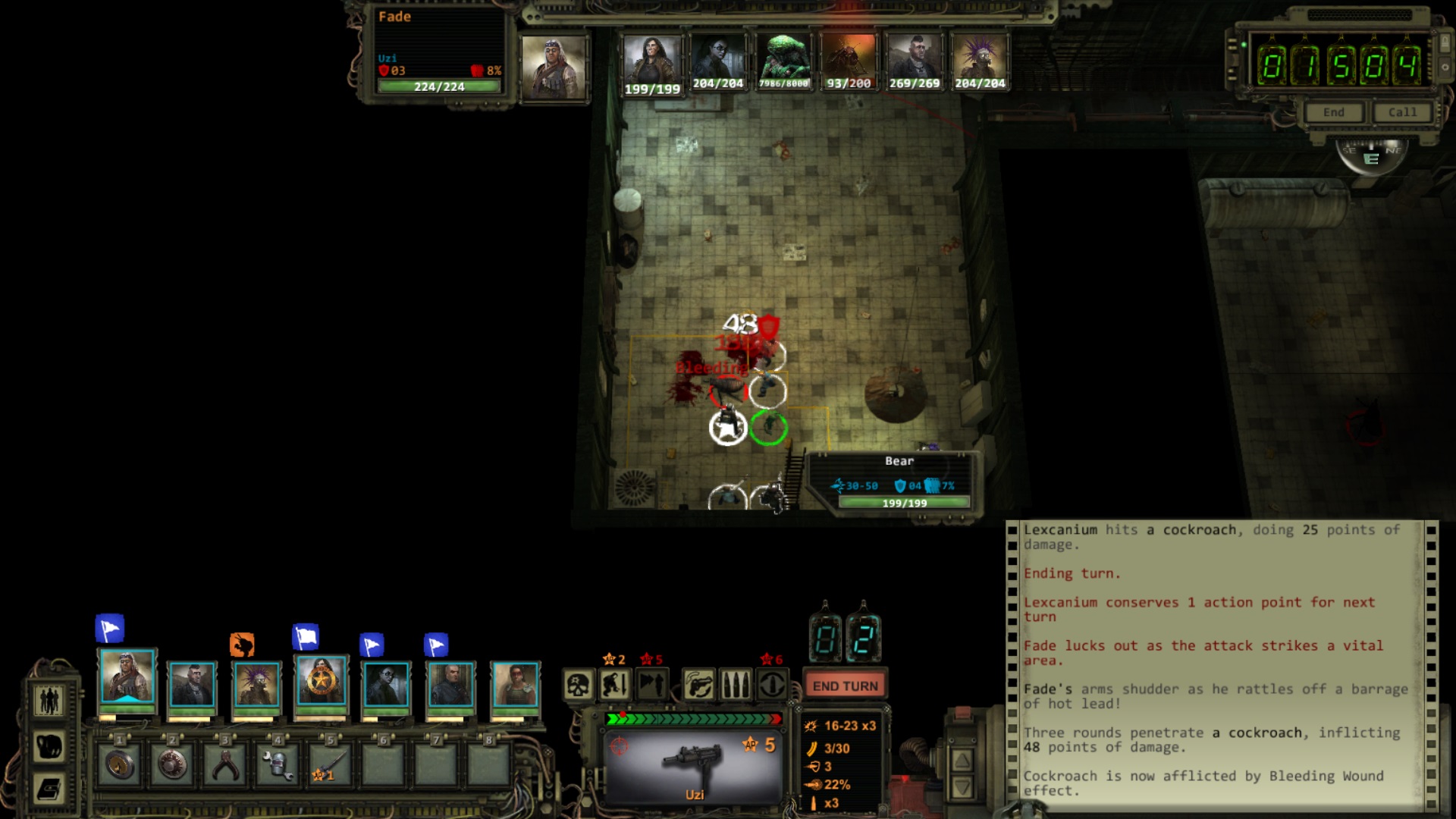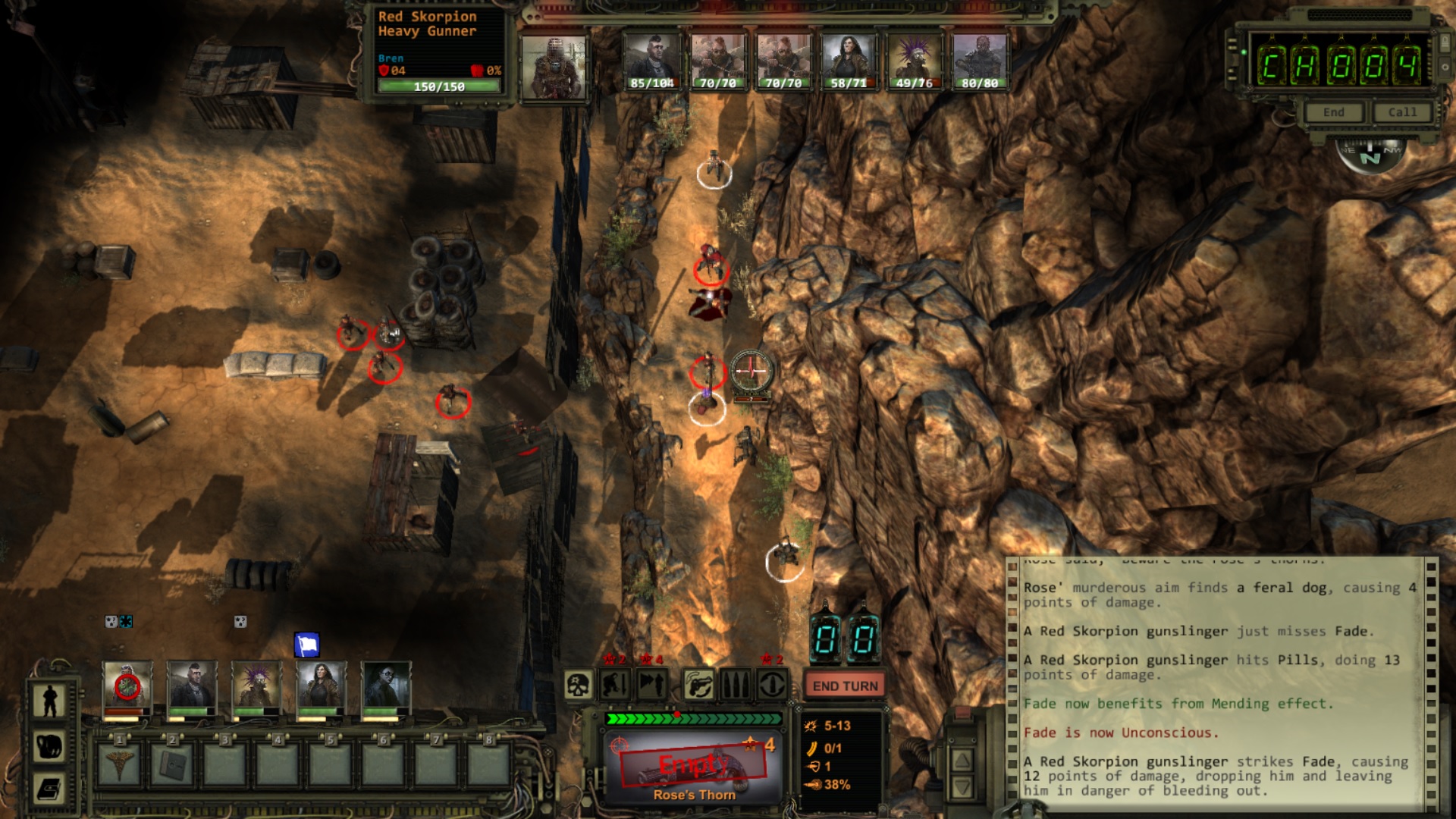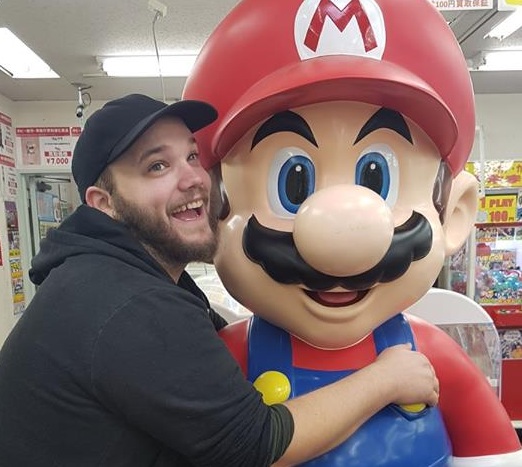
Welcome to the Wasteland, recruits, I hope you don’t think that Fallout prepared you for this. It didn’t prepare me. Wasteland 2 is a tactical turn-based RPG from inXile Entertainment and is the brainchild of Brian Fargo. It’s also harder than any game I’ve played in recent memory and I played the game on the normal difficulty setting. The original Wasteland was the spiritual predecessor to Fallout, a series I have given so many months of my life to, so I was keen to explore the world which “started it all.” I also think that makes Wasteland 2 and the modern Fallout games, like, spiritual cousins. Just a thought.

When the bombs dropped and the nuclear holocaust rolled in, a group of combat engineers from the US army took over a prison in the Arizona desert to ride it out. When they answered the cries for help from those helpless in the wasteland, they became known as the Desert Rangers. Now, years later, a veteran of the Rangers has fallen while investigating a mysterious radio signal. The task of finding out why and carrying on his mission falls to your squad of recruits – consider this your initiation to the Rangers, Echo One.

This was my first team. They lasted two hours.
Wasteland 2 doesn’t like to rush things when it comes to story-telling, taking the time to introduce the player to the world in which they inhabit. Though the main plot is hinted at early on, an awful lot of time in the beginning is spent just getting you acquainted with the world. In fact, the “bad guy” is somewhat of a mystery to be discovered, which helps to ensure that the player actually cares about the world which is about to be threatened. You will absolutely invest a lot of time into this game, even just on a single playthrough. As of the time of writing this article, I’m around the 85-hour mark and I’ve no idea if I’m even close to the end. Truthfully, I… I’m not sure I want it to stop. Much of that time has been spent reading all of the descriptions, journals, conversations and lore that’s around and I’m smitten with all of it.
The game is pretty text heavy, as previously mentioned, though if you have the patience to do a lot of reading then it really is quite rewarding. The world of Wasteland 2 is as rich with lore as it is expansive in size. The events of Wasteland 2 take place only a few years after those of the first game, borrowing heavily from its storyline and characters. Every location had a long heritage to discover, every character a tale to tell, and no inconsistencies, thus far, that I can see. Being peacekeepers, you’ll get right into the thick of things and begin to form some pretty strong opinions and feelings about certain folks in the Waste. I love a game that can make me genuinely feel the emotions my characters would be feeling, being angry, frustrated, excited or happy whenever they would (or should.) Wasteland 2 provides dem feels in spades.

Oh God, I can’t.. I just… is anyone watching?
If there’s any criticism of the story to be shared it’s that sometimes there’s too much happening at once for the player to focus on. There are several moments where a number of scenarios are flung at the player, always urgently, but not always gracefully. An example of it being handled well is from the beginning of the game: The player is faced with two distress calls and the option of saving only one. Whichever one you pick, you’ll receive periodic transmissions from the other about what’s happening there without your presence. The consequences of your action and inaction respectively will follow you for the rest of the game, making the whole scenario feel significant and impactful to the overall story.
Sometimes, however, you’ll complete a mission for the main storyline and begin to proceed to the next one before being waylaid by something irrelevant. Often by the same person giving out the quests. There’ll be scenarios which are presented to you as being incredibly urgent, before something else incredibly urgent comes up. Somehow, some of these “urgent” things are able to be delayed indefinitely for as long as needed. If there were more “lull” periods worked into the main story to allow for the side-stuff then the pacing might have felt better. As it stands, however, there’s certainly a lot of rushing and sudden stops which break the immersion up somewhat.
I’m not often a fan of turn-based tactical RPG’s. The genre was a bigger barrier for me than the dated graphics or mechanics when playing the original Fallouts for the first time. They feel too restrictive for my tastes, forcing you to sit there while enemies take swings at you, and at the same time using overly complex fighting mechanics to run it all. I prefer my mindless slaughter and chaos to be free-range. The skill system in Wasteland 2 however is so specific, sometimes.. oddly specific, that it’s all fairly straight-forward. The skills menu even shows the success ratio for each skill based on their level. Want to fire assault rifles good? Put skill points in assault rifles. Want to stop your insides from becoming outsides? Surgeon skill’s where it’s at. Feel the dire need to go foraging around in late 20th-century breakfast equipment? Yeah… there would be some freaks like you lurking around Steam.
This all might sound obvious, of course, you’re going to be better at something when you practice at it, right? Well, no, not exactly. Having no points assigned to a skill just means that you cannot do that thing. Having only a few skill points in something, however, means you’ll probably kill yourself when you use it. Beefing up your “Brute Force” skill? Good idea, maybe when you get it to level five or so you won’t break your leg when you kick a fence. Putting some points into “Lock Picking”? Handy skill that one, a wise investment, and in a few levels you can brute force all the locks you’ll destroy until you level lockpick a bit more. On one hand, it does encourage players to cultivate the characters’ skills carefully and make smart decisions about where points are spent. Ultimately, playing like this leads to a god-like party which fearlessly stomps across the wasteland. The other hand isn’t there, you cut it off because you only have two points in bladed weapons.

Just don’t put any points into substance abuse. It ends the game pretty quickly.
Combat in Wasteland 2 can be simultaneously the most exciting and most frustrating aspect of the game. The turn-based action, usually, suits the pacing of the game quite well, though it can also slow things down at times. It gives boss fights and long-awaited encounters the time and attention they deserve, making the player think harder about their actions. It also means that encounters with low-level enemies take way longer than they should. This is mostly due to the fight and movement animations, as well as some odd choices by the AI. Depending on the enemy, or even on your characters, the act of moving from A to B can be painfully slow, to say nothing of certain attacks. This is exacerbated further when the AI decides to aimlessly run back and forth a couple of times before settling on an action.
When the game is working without issue, however, and your enemy actually poses a threat, the combat holds some really intense moments. Characters can die easily and unexpectedly, making assumptions about never-before-encountered enemies can be a deadly mistake, and a Ranger out of cover is a dead Ranger. Despite being dangerous a lot of the time, a lot of thought has been put into allowing players time to make the most informed choices. The ground surrounding each character is highlighted to show how far they can move and still use their equipped weapons. Each position will also display its bonus to hit and evade, and there’s no time limit to force players into making rash decisions. It’s always great when a well thought out plan comes together and, most of the time, having one in Wasteland 2 will result in exactly that.

This guy murdered his way through five towns before I finally tracked him down.
When not shooting the inhabitants of the Wasteland in the face, interacting with them can sometimes be touch-and-go. Some characters have a problem with indicating to the player just how urgent each scenario is in comparison to the rest of the game. Some missions will allow you to leave the location you received them in and come back as often as you like before completing them. Others require you to complete them entirely, right then and there; leaving the location you received them in will cause the quest giver to flip out over the radio at you. You’ll fail the quest and, yes, everyone in the Wasteland will absolutely know about it, remember it, and hate you forever because of it. Also, pro-tip: Save very often while playing this game, and across multiple files.
The beginning of Wasteland 2 is brutal and to say that it’s unforgiving would be an understatement. If you can get through your first playthrough without save whoring or just out-right restarting the game, then you are a god damned hero. The need for the Desert Rangers becomes very apparent within the first few battles: Your characters, being level 1 and thus representative of the people you aim to protect, are awful in a fight. Accuracy, with any weapon, is just not an inherent trait in the wasteland, and your squad is squishier than fruit left in the sun. After a dozen or so fights under your belt and some wisely spent skill points, the game does become a lot easier as time goes on. Having clawed my way from cannon-fodder with a pistol, the greater firepower that comes with higher levels really feels like a much more tangible reward.

Assuming you live that long, of course.
The difficulty curve throughout Wasteland 2 isn’t so much a curve as it is a rollercoaster. You can have all the skill in the world, the most highly-trained fighters in all the Wastes, and you’ll still end up reloading a few times out of awful luck. For instance, the outcome of battles, more often than not, were determined by whose weapons jammed more. Weapon jamming, specifically, in this game was quite bad – the statistics provided for weapon jamming in each of the guns’ readouts are nothing but filthy lies. Every character in my party having their weapons jam on them in a single round was not an uncommon occurrence while playing. Firearms in Wasteland have more jam than an English breakfast. What’s most frustrating about these moments is that unjamming your weapon will (usually) take up an entire turn, slowing down gameplay.
Exploration in this game is great, it really, really is, especially when the sense of danger that the game creates is actually real. Locations remain hidden on the overworld map until you’re either told about their co-ordinates or you stumble across them. Random encounters also take place in the overworld map, which can very well be the end of you if you’re low on supplies and can’t avoid them. Hidden caches lie around the map, mysterious shrines which give you boosts, even exploring the nooks and crannies of each location can yield incredible rewards. Some of the best weapons I’ve used in the game were found in random boxes, hidden in dark corners. So were traps which laid out half my team. When something as simple as finding a lone box in the middle of nowhere can have me excited and filled with dread all at once, that’s exploration done right.

Life is like a box of… Ew.
By far and away, the biggest challenge of Wasteland 2 is getting the damn game to start, it’s greatest villains the bugs. For a game that had such a long beta period, Wasteland 2 has a lot of technical problems. Lighting and focus would be regularly stolen by the cursor during encounters, causing shadows and lighting to freak out and preventing me from interacting with characters. Without a sufficiently leveled leadership skill, followers will regularly go rogue and do what they feel like. Makes sense, right? Well, not when they make the worst decisions possible. By the time I reached level 18 with most of my team, my followers had been through more than a few battles and should be aware of the basics of tactical fighting at least. Yet they were still running right up to killer robots and trying to flog them in the face with their fists. They never even attempt to swap weapons of use other skills – whatever’s in their hands at the time is just fine and it’s going right into the face of the closest enemy.
Starting the game itself can be a challenge, particularly after updates, usually having to kill the process and restart it a few times before it would successfully launch. At one moment, a random encounter appeared while I was checking out a previously unexplored part of the map. It froze and wouldn’t allow me to dismiss it, however, my characters continued walking… right into an undiscovered rad zone, killing them all. I wouldn’t have been so angry, if not for the fact that I hadn’t saved in awhile. Also, pro-tip: Save very often while playing this game, and across multiple files.

Rad zones, otherwise known as “Walls of Nope.”
Graphically the game isn’t the most spectacular thing out there and, really, that’s just fine. What Wasteland 2 lacks in graphical prowess it more than makes up for in world building and atmosphere. Almost every object and area has been given a description for players to read, filling in the mental gaps what graphics can’t provide. When accompanied by a great soundtrack and convincing voice acting (where it’s present), it’s easy to get sucked into the world that the game creates. It maintains the “western frontier,” theme well throughout the game while still keeping the player grounded in a sci-fi, post-apocalyptic world. Old-world tech becomes new-world salvage and everywhere you go has a “recycled” look about it, really driving home the point that humanity has been left to carry on with very little.
Like many other things in this game, however, the voice acting feels distinctly “unfinished”. Some characters that are voiced, for instance, have a lot of lines which haven’t had dialogue recorded. Some characters haven’t been voiced at all, which is to be expected in a game that has so many, though there are some that you might expect to have been which haven’t. It can ruin the immersion when text dialogue appears for a suddenly silent and gesticulating character, like subtitles for some bizarre interpretive dance. Characters’ portraits, descriptions, and character models don’t always match up either, which made for a few hilarious mistakes here and there.

You don’t say…?
 Immersive story
Immersive story
 Great combat
Great combat
 Atmospheric and expansive world
Atmospheric and expansive world
 Rewarding exploration
Rewarding exploration
 Bugs. Bugs everywhere
Bugs. Bugs everywhere
 Occasionally slow gameplay
Occasionally slow gameplay
 Frustrating AI
Frustrating AI
Overall, Wasteland 2 is one of the greatest RPG’s I’ve ever played, if not one of the greatest games, period. It’s incredibly absorbing, with a huge world, a vast array of well-written characters and a plot that is worth the wait for it to actually start. The game has more than it’s fair share of bugs, which is disappointing given the long beta period that the game went through. That being said, they’re still releasing updates for the game to fix these issues and the experience is getting better overall. Time will tell about whether or not these will fix things like strange or frustrating AI behavior and unbelievably high odds of weapon jamming. The unpredictable nature of the games’ various characters and bugs means that I cannot stress enough: Save very often while playing this game, and across multiple files.
The design is otherwise fantastic, with only a few minor issues, and has me enthralled despite being a genre I’m not normally interested in. I’ve put so much time into Wasteland 2 not because I had to for the review – I probably could have finished this article days ago. I’ve racked up so many hours because I couldn’t pull myself away from this game. Even writing about it here just made me want to go back and play it. Which I would, and every time I would be playing for hours, to the detriment of this article, work, I think I had, like, a cat somewhere… But, that’s okay because I can deal with it later, I’ll just.. I can play awhile longer.. A couple of hours… Excuse me.











